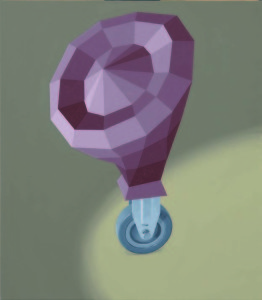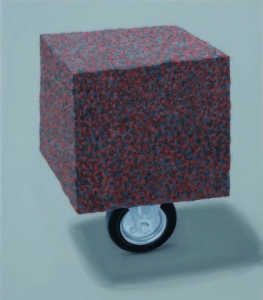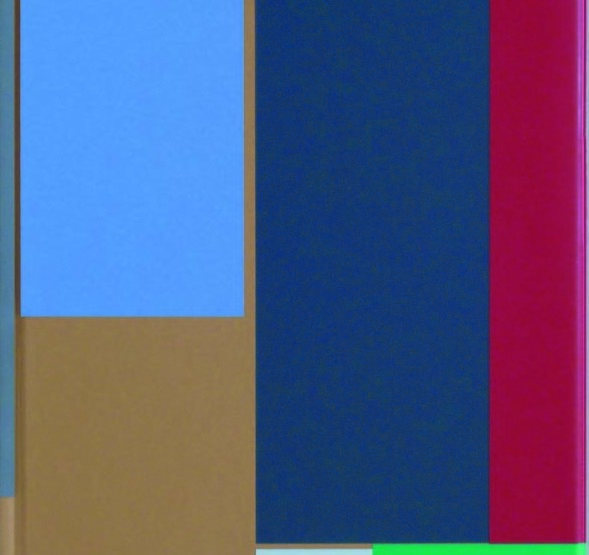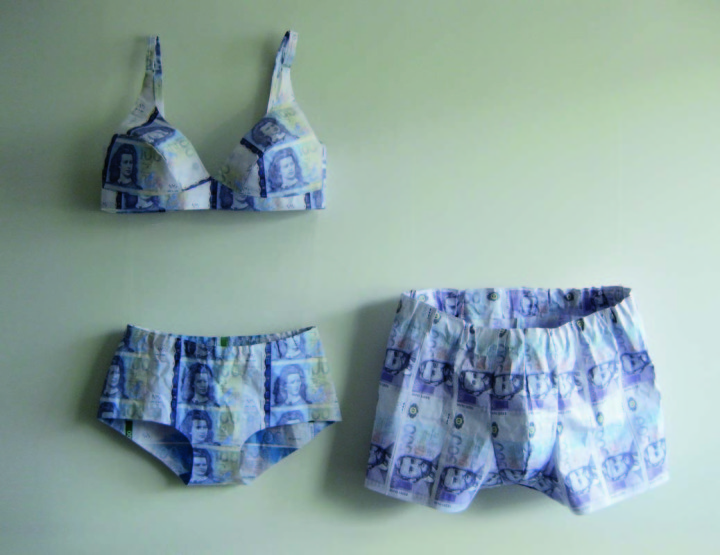I am truly happy that Kaido Ole no longer has to paint self-portraits with heads that swell like question marks and finally explode. Or depict an artist riding a pencil. Or the way he would push this particular means of painting down his own throat.
Kaido Ole’s new exhibition Handsome Hero and Plenty of Still Lifes at the Kumu Art Museum offers, after anxious questions, numerous significant answers. The justified price of that, according to the artist, is the above-mentioned images in the exhibition hall (Kaido’s Art School, Hobusepea Gallery 2010) and in the studio.
Precisely 11 years have passed since Kaido —-Ole’s previous big exhibition Basic (Rotermann Salt Storage, 2001). In the opening speech of that exhibition, the art historian Eha Komissarov praised the artist as one of the few who had moved from the abstract towards the figurative. Looking at today’s display, which has a nomenclature analogous to the past one, we notice that, in creating new paintings, Ole has used nearly his entire stylistic and figurative arsenal, from the very beginning, although adding some new methods. He has moved away a bit from literary depiction, and the new works leave a surprisingly good impression, as nobody quite expected this kind of Kaido Ole.

Kaido has claimed that he is not interested in the past and old things; the future matters only in order to call a halt in a dignified manner. What matters is always here and now. Regarding the current exhibition, it does not seem to be quite so simple, but a critical number of changes in his artistic arsenal have been successfully achieved.
Kaido remembers how the poet Andres Ehin once came to his school in Rapla and read the first poem in Spanish. It was cool, simply because. Ole’s exhibition at Kumu seems, similarly, to be in a foreign language. Probably partly because we do not remember all his previous work, and certainly because the artist has made a maximum effort to divert the public from prejudiced paths. Ole’s starting point in that new quality is defined by unexpectedness, and it seems methodically valid. Looking at the works, it becomes apparent that youthfulness and freshness are issues of continuing attitude rather than of time. Ole has repeatedly called himself a modernist (a hopeful seeker), and he allegedly produced this exhibition, too, from the outside to the inside. He primarily meant how this involves filling the given space with pictures and how much painting that would take.
In the exhibition hall, visual parallels inevitably arise with the work of Miks Mitrevics and the latest work of Sigrid Viir, as all three artists mix various consumer goods into weird poetic composites outside their original function. The three artists also all rely on playing with balance, symmetry, laws of physics and different types of matter. Only Mitrevics and Viir work in installation and photography and their work must really and spatially hang together. Kaido Ole’s paintings, on the other hand, have discarded gravitation and balance, and act more selfishly and playfully. There are practically no documentary points of contact at the exhibition, except the systematic, realistically painted wheels under every composition.

A large part of contemporary art, which has pretentions of solving problems to the full, technically works on the principle of the vacuum. The place is pumped empty of any excess oxygen, and the focus emerges in the context of strong negative pressure. Tension is achieved by purity, as a contrast with the background of chaotic surroundings. In his picture series, the same has been accomplished by Ole, although at this exhibition we do not see linear processes with clear beginnings and endings, such as the earlier burning of a paper house (Look Out, Matches II, 2006), cutting off of fingers (Speed III, 2004) or a man and woman undressing with their backs turned to each other (Two, 2003). A symbolic vacuum is here created by realistic wheels in illogical balance, which carry spatially, essentially and materially unequal composites.
The display of Ole’s still lifes is airy and oxygen-rich and, perhaps for that reason, a large part of the audience heaved a sigh of relief at the opening, because the display, realised purely by means of painting, easily filled the entire room and expanded the rooms of imagination.
Looking at the pictures in random order, some works become quotations in my memory and compete with other works, e.g. Still Life in Three Colours (Ando Keskküla Still Life XI and A Big Still Life I), Still Life in Memory of G.R. (Gerhard Richter’s series of candles), Still Life with Burning Tallinn and a Broken Pipe (Velikije Luki Tallinn Burns, and Jaan Elken’s abstractions painted on red slogans), Small Still Life with a Stone (Neeme Külm’s Cow Cast in Concrete), and Small Still Life with a Self-made Design Form, which directly quotes Ole’s own work in the mid-1990s. The paintings are technically more diverse and colourful than those completed since the mid-1990s, but they are also more individual. The exhibition, consisting of canvases of special formats, has no beginning and no end, but it does have an epicentre: Handsome Hero. The images of a circle and circulation have been crucial throughout Ole’s working life – ball-heads, loudspeakers, a ring of colour and a wheel – and if you ask him why this is he will probably say that the world is, after all, round too. Simple, but true. Or that he has also worked with rectangles and triangles. Also true. However, the current exhibition can structurally be seen as an analogue of the solar system, where a number of smaller planets orbit around the epicentre, besides orbiting around their own axes. Kaido has never been intimidated by big and simplified comparisons.
The coloured side panels of the central work Handsome Hero have a purely abstract quality: slightly tattered wood fibre plates are naturally worn and pale, covered with accidental white powder. All this together seems as if the materials come from an unfinished interior. The artist has never concealed his preference for building materials and living space aesthetics over traditional painting, and his treatment of colours has always been a carefully designed short distance in the painted space, rather than a conscious regard for traditional colour perspective or natural topics of chiaroscuro.
He has always seen painting as the job of making pictures which can be adapted according to the available space. It is thus no surprise that, in colours and perspective, he relies on the rules of a possible interior rather than the objective exterior. As far as I know, Kaido has very few exterior views, landscapes or nature paintings: Brezhnev’s grave, painted together with Marko Mäetamm (John Smith Brezhnev, 2001), a green slope with Hollywood-style letters, HOLOCAUST ( John Smith Holocaust, 2001), and an aerial photograph of Rapla (John Smith On the Airplane, 2003 and Marko und Kaido II, 2002). These resemble comics and do not have any stylistic pretensions. The more so that all the above-mentioned paintings are presented as pictures inside pictures, a view out a window.
Ole has always got the sound, and taste and tastelessness are such polar concepts for him that he is actually unable to confuse them, so he just has to choose among his skills and knowledge. I don’t think it is accidental that the exhibition’s only grating picture is entitled Still Life with Ill-fitting Objects.
The Band (2003–2005) series used to have an additional two carved wooden figures, of a boy and a girl, which the artist asked someone else to produce, so that they would be authentically weird independently of him. The guest artist Marta Stratskas exhibits a few expressive pieces, which in Kaido’s words he was not able to produce; all personal themes in different painting trends are presented as a card catalogue on equal-sized wheels, each as a possible painting method and not as the only correct solution. The only thing that is objectively correct is the overall picture, the exhibition structure.
Although the painted wheels underneath compositions are there to provide a fragile balance and not to force movement, images of the possible variations in this series roll towards open infinity. This may sound like an art merchant’s argument but, firstly, a series of still lifes can be continued ad infinitum and, secondly, it can successfully separate single instruments or groups of instruments from the whole, whereas a symphonic dimension is only guaranteed by a massive compact work.
It is no wonder that what we always first associate with Kaido is his essential modernity, his contemporaneousness. Many know exactly how tight the trousers can be you want to pull on but, in the case of Ole, his content and form constitute an original and natural, even a timeless whole. Contemporaneousness as a concept, not as a changing aesthetics. At the same time, Kaido has never concealed his affection for new things and bourgeois comforts, although the undertone of this affection is a wish to be socially normal, resemble others, and show solidarity in his position. Another thing that I always associate with him is the artist’s desire for democracy, a right, together with adequate duties and freedom, to do exactly what you wish, although some things are of course inevitable. This, however, is not polite social democracy, but more demanding and total, something ideally resembling an equal-opportunity monarchy, where everybody is king. Quite an unrealistic ideal, but Ole will not give it up easily.
He has no problem painting an identical picture of his Great-Uncle Eduard Ole’s Table (Eduard Ole, Table, 1924 / Kaido Ole Table, 1996), although the comparison embarrassed him. He frankly admitted that “the clumsy bits where Eduard had clearly failed, I managed much better”. He willingly supervises students in a week-long workshop, where they paint copies of his famous loudspeaker, although at the end of the week he asks each to put their own name on the back of the picture. Just in case. He has no problem speaking, together with students, in a school hall to explain art to young people, even if this requires silly dance movements or a sincere confession about his connection with jumpers knitted by his mother. Kaido does not like theatre, because it involves acting. When someone shits his pants on stage, he does this as an actor, and it cannot be compared with the real act, which anyone would like to show others. Every evening at the same time. Or do you know anyone who is so annoyed by a tasteless or unsuitable design of an original record sleeve that it must be removed to ensure any enjoyment of the music?
The above attempt to characterise Kaido Ole is certainly quite fascinating, and we would not have known it if he hadn’t talked about it himself. Kaido is indeed often portrayed as a pedantic style guru, great fun and a tireless storyteller, which is all naturally true. But how often do people notice a desperate effort behind his openness and occasional brutality to conduct a dialogue where nothing is lost, a wish to achieve final clarity and understanding, through fully open discussion on a totally equal basis? I have a feeling that talking is a method that Ole uses to realise his ideal democracy, because you can, after all, talk with anyone about anything. Either about art or a new-fangled gadget. Ironically, this often works against him and the dialogues turn into lengthy monologues, where the speaker himself finally gets lost. The inevitable weakness of his monologues and destructiveness in finding a positive solution is obvious in his double painting Speed I (2004), where two cars called Kaido and Ole crash head-on. The same can be seen in the painting Self-love (2006), where Kaido and his twin brother stand bravely in water but are unable to save the burning paper navy, because one brother wears a black and the other a white shirt, and they keep close to each other. Thus, in terms of a positive answer, he values dialogue outside himself. And being positive, or rather avoiding pessimism, is in his view a conscious consideration at this exhibition (‘Kaido Ole, at 48’, Sirp, 27.01.2012).
Kaido has often depicted both questions and answers in his work. He has replaced long monologues in conversations with progressing picture series or monotonous repetition, for example 36 silent loudspeakers. However, isn’t it inevitable that graphically expressing, word-by-word, some kind of literary train of thought turns into caricature? Isn’t it too one-sided and predictable, dull and unnecessary in the longer perspective? Isn’t the only thing that saves everything from caricature the kind of vagueness or openness existing in loudspeakers, Self-love and colour circles (Questions, 2008)?
The photo installation Meeting (2007) shows a cross-section of society sitting at a long table, but the chairman’s seat is empty. In the video Anthem (2007), a dozen or so people sing one word in the anthem and the end result is a democratic song. The series of paintings Questions mixes the main colours in different sectors of a circle into a spiral, an increasingly dirty psychedelia, depending on how vigorously they have been spread along the radius of the circle with an even brush. A grey and serious question mark sits in the middle of the paintings.
Caricature potential is also seen in his new paintings Big Social Still Life I and II, where a basketful of brown brushstrokes supports a similar but single brushstroke sitting in a large cube. In fact, his entire 11-year-old series of paintings called Basic can be regarded as caricatures, where grey ball-heads do everything we as humans do every day. Works at the new exhibition, such as Still Life with a Green Plate, Colourful Still Life and Still Life with Three Boxes of Ultramarine, seem like caricatures of painting itself. The question is not whether a caricature is essentially good or bad, but rather to what extent literariness maintains an interesting balance with the chosen medium. Or how can one underline a specific quality that would distinguish the end result from possible alternatives? It seems to me that the question presented as a dirty circle of colour is from the visual culture’s point of view clearly smarter than a painted question mark.
The strongest caricature parallel at the exhibition is inevitably linked with its central work Handsome Hero – a chequered monster holding a torch or a flower, standing on the same kind of wheels as the smaller still lifes. The only person at the exhibition besides the torch-holder is Kaido himself, who looks up at the hero. Against the background of all Ole’s earlier work, this is perhaps the most illustrative construction of the topic of potential answer, and consciously the most hollow, ironic, embarrassing and hopeless. At the Meeting, the seat of the chairman was fortunately empty.
Who, after all, could be the one and only hero (for Kaido Ole)? As far as I know, Ole does not believe in any god. Politically, he is unable to define himself either as left- or right-wing. I have never known his favourite artist, band, perfume or film. If the evening telly is showing CSI, he probably watches it, but soon it will certainly be switched to something else. Ole also hates any kind of patronising attitude towards himself or others.
However hard he tries to put together a chart to establish the leader, he keeps in mind the intelligent and avant-garde question: who is the second, third…
The role of Handsome Hero is obviously to rehabilitate the surrounding paintings by comparison. We make a fuss about the fact that we always notice the biggest and the most clearly delineated first, that the hero’s concept is faulty because he is often nothing but handsome, and we cannot identify with him, although on the basis of smaller similar features we should deal with both ourselves and the surroundings, without seeing similar wheels that have been so illustratively painted underneath. They are different but they are there.
I have recently quite often caught myself in the heretical thought that when a reply takes a long time to come, maybe there is something wrong with the question. I am not sure whether it always works like that in practice, but it seems fitting for Kaido’s new paintings. A few years ago our conversations concluded with the observation that an idea was good, but not a good painting-idea, whereas looking at today’s exhibition, it is quite clear that it primarily rests on painting ideas, and their controllable intellectual goodness is placed on a tiny wheel underneath every composition. The laws of physics would not keep such a composition together but, from the point of view of the entirety of pictures, these wheels are an absolute necessity. Let us be honest – if the wheels were to be removed, the whole display would become legless. With the help of these delicate balance points, Ole has built up a large slice of world, and when at the opening I overheard someone’s slightly ironic ’World of Kaido’, it did not in the least diminish the artist’s brilliant idea of inserting these delicate balance points into our empathy. Because the imaginary attempt to remove wheels or move ’implausible’ pictures in either of the established plausible directions (abstract/realist) would cause the pictures to fall apart.
In Monologue, filmed by Flo Kasearu this obsessive talker, who himself claims to like to ‘wag his tongue’, sits alone for 35 minutes and 40 seconds on a chair in an empty exhibition hall. He faces his public, dusts the camera lens, makes an official phone-call; before the end of the video he changes his orange shirt for the same white one which he wears in his work where he stares at the great hero, and finally utters a more or less considered sentence. I think what he says is true and there is no need to argue with it, because the paintings in the exhibition hall are saying the same thing, only 28 times more excitingly.
Still Life in Memory of G.R. has a haunting effect. As a reference to Gerhard Richter’s series of candles, a living person (as of January 2012) depicted as dead evokes a slight sense of alienation. True, Richter will die as well one day, as he obviously has the same kind of realistic wheels as we all do.






